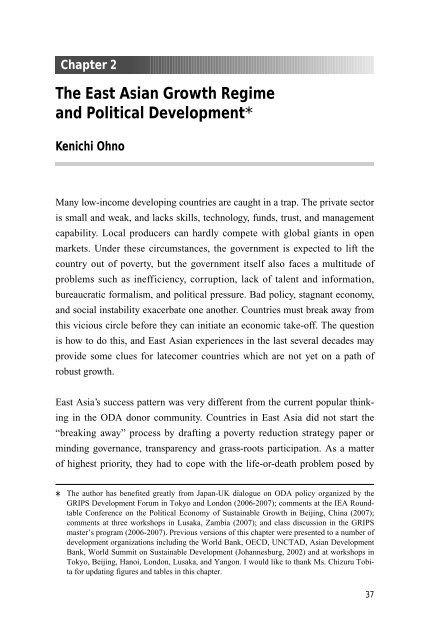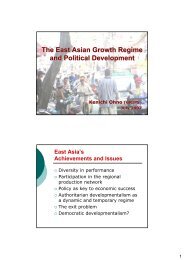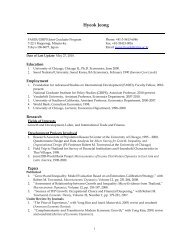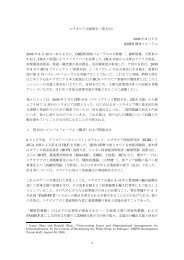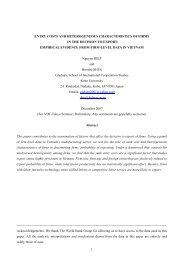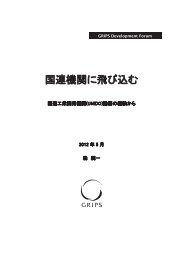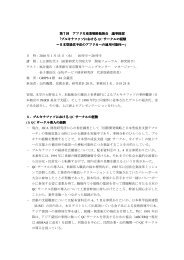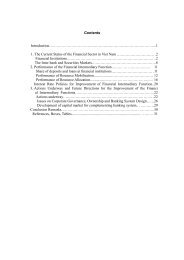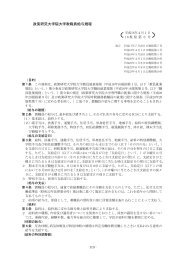The East Asian Growth Regime and Political Development*
The East Asian Growth Regime and Political Development*
The East Asian Growth Regime and Political Development*
You also want an ePaper? Increase the reach of your titles
YUMPU automatically turns print PDFs into web optimized ePapers that Google loves.
Chapter 2<br />
<strong>The</strong> <strong>East</strong> <strong>Asian</strong> <strong>Growth</strong> <strong>Regime</strong><br />
<strong>and</strong> <strong>Political</strong> <strong>Development*</strong><br />
Kenichi Ohno<br />
Many low-income developing countries are caught in a trap. <strong>The</strong> private sector<br />
is small <strong>and</strong> weak, <strong>and</strong> lacks skills, technology, funds, trust, <strong>and</strong> management<br />
capability. Local producers can hardly compete with global giants in open<br />
markets. Under these circumstances, the government is expected to lift the<br />
country out of poverty, but the government itself also faces a multitude of<br />
problems such as inefficiency, corruption, lack of talent <strong>and</strong> information,<br />
bureaucratic formalism, <strong>and</strong> political pressure. Bad policy, stagnant economy,<br />
<strong>and</strong> social instability exacerbate one another. Countries must break away from<br />
this vicious circle before they can initiate an economic take-off. <strong>The</strong> question<br />
is how to do this, <strong>and</strong> <strong>East</strong> <strong>Asian</strong> experiences in the last several decades may<br />
provide some clues for latecomer countries which are not yet on a path of<br />
robust growth.<br />
<strong>East</strong> Asia’s success pattern was very different from the current popular thinking<br />
in the ODA donor community. Countries in <strong>East</strong> Asia did not start the<br />
“breaking away” process by drafting a poverty reduction strategy paper or<br />
minding governance, transparency <strong>and</strong> grass-roots participation. As a matter<br />
of highest priority, they had to cope with the life-or-death problem posed by<br />
*<br />
<strong>The</strong> author has benefited greatly from Japan-UK dialogue on ODA policy organized by the<br />
GRIPS Development Forum in Tokyo <strong>and</strong> London (2006-2007); comments at the IEA Roundtable<br />
Conference on the <strong>Political</strong> Economy of Sustainable <strong>Growth</strong> in Beijing, China (2007);<br />
comments at three workshops in Lusaka, Zambia (2007); <strong>and</strong> class discussion in the GRIPS<br />
master’s program (2006-2007). Previous versions of this chapter were presented to a number of<br />
development organizations including the World Bank, OECD, UNCTAD, <strong>Asian</strong> Development<br />
Bank, World Summit on Sustainable Development (Johannesburg, 2002) <strong>and</strong> at workshops in<br />
Tokyo, Beijing, Hanoi, London, Lusaka, <strong>and</strong> Yangon. I would like to thank Ms. Chizuru Tobita<br />
for updating figures <strong>and</strong> tables in this chapter.<br />
37
CHAPTER 2<br />
external military threat or internal social fragmentation. To maintain national<br />
unity <strong>and</strong> military readiness, economic growth was considered imperative. A<br />
political regime that could h<strong>and</strong>le this situation, which we call authoritarian<br />
developmentalism, was established in a number of countries. This regime pursued<br />
economic growth at any cost <strong>and</strong> thus broke the poverty trap. New problems<br />
generated by fast growth, such as income <strong>and</strong> wealth gaps, urbanization,<br />
internal migration, environmental damage, <strong>and</strong> congestion were also recognized<br />
<strong>and</strong> dealt with.<br />
However, it must also be admitted that such regimes <strong>and</strong> policies, which may<br />
have suited the reality of the Cold War era, are a little too harsh <strong>and</strong> insensitive<br />
for developing countries today. Historical lessons must be learned in full<br />
recognition of circumstantial differences. This chapter proposes to learn from<br />
the <strong>East</strong> <strong>Asian</strong> experiences selectively <strong>and</strong> with modifications, instead of<br />
accepting or rejecting them totally <strong>and</strong> unconditionally.<br />
1. Good but uneven performance<br />
<strong>East</strong> Asia’s economic development has been quite remarkable, but high performance<br />
was not uniform across countries or over time. It is also difficult to<br />
argue that <strong>East</strong> Asia owes its success to good initial political <strong>and</strong> economic<br />
conditions. It is necessary at the outset to dispel these myths <strong>and</strong> emphasize<br />
the role of policy in achieving economic success. <strong>East</strong> <strong>Asian</strong> growth was generated<br />
mainly through competent execution of appropriate policies, as<br />
explained below, rather than spontaneous emergence of some inherent characteristics<br />
of the region such as diligence or Confucianism. Countries that did<br />
not implement needed policies or those that implemented them insufficiently<br />
have failed to participate in regional economic dynamism. Figure 2-1 shows a<br />
wide range of achievements in governance <strong>and</strong> economic development in <strong>East</strong><br />
Asia with a strong positive correlation between the two measures (0.90). 1<br />
1. At the risk of stating the obvious, it should be added that correlation does not necessarily imply<br />
causality, either from income to governance or vice versa. More information <strong>and</strong> analysis are<br />
needed to argue causality.<br />
38
<strong>The</strong> <strong>East</strong> <strong>Asian</strong> <strong>Growth</strong> <strong>Regime</strong> <strong>and</strong> <strong>Political</strong> Development<br />
Figure 2-1: <strong>East</strong> Asia: Governance <strong>and</strong> Income<br />
Goverance, WGI2005<br />
600<br />
500<br />
400<br />
300<br />
200<br />
100<br />
0<br />
100<br />
E Timor<br />
Mong<br />
VN<br />
Camb<br />
PNG<br />
Lao<br />
N Kor<br />
Mya<br />
Mal<br />
Thai<br />
Indo<br />
Phil<br />
China<br />
Sin<br />
S Kor<br />
Jpn<br />
Twn<br />
Bru<br />
Hkg<br />
1000 10000 100000<br />
Per capita income ($PPP2004, log scale)<br />
Sources: Compiled from World Bank, Worldwide Governance Indicators; <strong>and</strong> World Bank,<br />
World Development Indicators (2006). Unofficial income data from various sources are<br />
used for countries without World Bank income data.<br />
Note: Worldwide Governance Indicators consist of six dimensions (voice <strong>and</strong> accountability,<br />
political stability, government effectiveness, regulatory quality, rule of law, control of<br />
corruption) with each carrying 0 to 100 points. <strong>The</strong> vertical value in this diagram simply<br />
adds these points for each country or area.<br />
While the precise geographical definition of <strong>East</strong> Asia may be debatable, it is<br />
safe to say that only a subset of economies belonging to this region have<br />
achieved or are achieving sustained economic miracles. Japan, Singapore, <strong>and</strong><br />
Hong Kong have already reached high income <strong>and</strong> life style comparable to the<br />
richest countries in the West. Taiwan <strong>and</strong> South Korea are very near that level.<br />
Malaysia, Thail<strong>and</strong>, China, <strong>and</strong> Vietnam, although in different development<br />
stages, are moving up rapidly. <strong>The</strong>se nine economies are full participants in<br />
the <strong>East</strong> <strong>Asian</strong> production network. On the other h<strong>and</strong>, Indonesia <strong>and</strong> the<br />
Philippines have been integrated in regional dynamism, but their performance<br />
<strong>and</strong> future prospects are more precarious. 2<br />
2. In 2007, Thail<strong>and</strong> is also facing political <strong>and</strong> economic difficulties following the ousting of former<br />
Prime Minister Thaksin. However, this situation may be temporary given that Thail<strong>and</strong> has grown<br />
fairly consistently in the past despite many political crises <strong>and</strong> a persistent urban-rural income gap.<br />
39
CHAPTER 2<br />
Additionally, a number of economies lie outside the <strong>East</strong> <strong>Asian</strong> Factory for<br />
various reasons. Cambodia, Laos, Mongolia, Papua New Guinea, <strong>and</strong> <strong>East</strong><br />
Timor are struggling for political stability or economic take-off, or both. At<br />
this point, Myanmar <strong>and</strong> North Korea are political outcasts for which no<br />
meaningful growth strategy can be discussed. Finally, Brunei is a small oilrich<br />
country that does not join the flying geese formation.<br />
<strong>The</strong> paths travelled by <strong>East</strong> <strong>Asian</strong> economies have been far from smooth.<br />
When Gunnar Myrdal wrote <strong>Asian</strong> Drama in 1968, Southeast Asia was considered<br />
to be a region trapped in dire poverty. He argued that the only way to<br />
get out of it was through population control, more equitable l<strong>and</strong> distribution,<br />
<strong>and</strong> investment in health care <strong>and</strong> education (FDI-led growth was not mentioned).<br />
According to historical statistics compiled by Maddison (2001),<br />
shown in Figure 2-2, Africa had a higher average income than Asia in the<br />
1950s. China, now the mighty factory of the world, was mired in political <strong>and</strong><br />
economic confusion in much of the 1950s, 60s, <strong>and</strong> 70s. <strong>The</strong> Cold War turned<br />
hot in the Korean Peninsula <strong>and</strong> Indochina, <strong>and</strong> tension continued across the<br />
Taiwan Strait, all of which severely affected the political economy of the<br />
entire region. In the late 1950s, South Korea was considered a basket case<br />
under an incompetent leader with rampant corruption (see Section 5).<br />
More recently, growth was interrupted by various events such as the oil shocks<br />
in the 1970s, the ASEAN recession in the early 1980s, Japan’s lost decade in<br />
the 1990s, <strong>and</strong> the <strong>Asian</strong> financial crisis in 1997-98. It is therefore difficult to<br />
argue that <strong>East</strong> Asia grew fast because the region enjoyed peace <strong>and</strong> stability<br />
or because it had inherited better initial economic conditions than Sub-Saharan<br />
Africa. Policy, not external circumstances, made the critical difference.<br />
2. <strong>Growth</strong> policies <strong>and</strong> social policies<br />
<strong>The</strong> development strategy of the global ODA community shifts every several<br />
years. <strong>The</strong> current strategy focuses on the Millennium Development Goals<br />
(MDGs) proposed by the United Nations in 2000, which feature poverty reduc-<br />
40
<strong>The</strong> <strong>East</strong> <strong>Asian</strong> <strong>Growth</strong> <strong>Regime</strong> <strong>and</strong> <strong>Political</strong> Development<br />
4000<br />
Figure 2-2: Per Capita GDP<br />
(Measured in 1990 international Geary-Khamis dollars)<br />
3500<br />
3000<br />
<strong>East</strong> Asia<br />
2500<br />
2000<br />
1500<br />
Africa<br />
1000<br />
500<br />
0<br />
1950 1960 1970 1980 1990 1998<br />
Source: Maddison (2001).<br />
tion <strong>and</strong> attainment of seven other social goals in the period between 1990 <strong>and</strong><br />
2015. Moreover, governance is also targeted as a main pillar of development<br />
effort. However, it is now widely recognized that meaningful poverty reduction<br />
cannot be achieved only by shifting existing resources around or improving<br />
education <strong>and</strong> health care. Economic growth is absolutely necessary for sustained<br />
poverty reduction <strong>and</strong> avoidance of permanent aid dependency. But the<br />
global ODA community seems at a loss as to what concrete measures are<br />
required to generate long-term growth, especially in Sub-Saharan Africa.<br />
<strong>The</strong>se questions were alien to <strong>East</strong> <strong>Asian</strong> development thinking, where growth<br />
has always been the central objective for which policies <strong>and</strong> resources were<br />
mobilized. For <strong>East</strong> <strong>Asian</strong> countries, poverty reduction was one of the many<br />
natural fruits of competent economic management rather than an overarching<br />
goal toward which every development effort must be exerted. In fact, reducing<br />
poverty was a goal too small for them; <strong>East</strong> <strong>Asian</strong> states invariably pursued a<br />
more ambitious goal of greatly improving technology, competitiveness, <strong>and</strong><br />
living st<strong>and</strong>ards so as to join the ranks of advanced countries <strong>and</strong> establish a<br />
respected stature in the world economy.<br />
Despite various differences among countries, there was a general policy orientation<br />
followed by all successful economies in <strong>East</strong> Asia. This policy orienta-<br />
41
CHAPTER 2<br />
tion had two main components: growth policies <strong>and</strong> social policies. <strong>Growth</strong><br />
policies include st<strong>and</strong>ard measures that ignite <strong>and</strong> sustain private-sector<br />
dynamism such as provision of indicative visions, plans, <strong>and</strong> strategies;<br />
human resource development; technology; infrastructure; SME promotion;<br />
FDI attraction; finance; <strong>and</strong> subsidies. 3 Social policies are a set of measures<br />
that cope with problems associated with rapid growth, such as inequality, pollution,<br />
urbanization, congestion, labour migration, asset bubbles, corruption,<br />
illegal drugs, materialism, <strong>and</strong> decline of traditional values <strong>and</strong> customs.<br />
<strong>Growth</strong> policies are primary <strong>and</strong> social policies are secondary, in the sense<br />
that the latter ameliorate new problems generated by the successful execution<br />
of the former.<br />
Yasusuke Murakami (1992, 1994) stresses the importance of simultaneous<br />
execution of growth policies <strong>and</strong> social policies (which he calls “supplementary<br />
policies”) in order to avert the negative aspects of developmentalism. As<br />
Murakami (1994) puts it,<br />
When targeted key industries begin to grow rapidly, people in these<br />
<strong>and</strong> related industries will experience a shift in life style <strong>and</strong> even in<br />
attitude toward life. … [E]specially in latecomer countries, social<br />
structure, including the national psychology, will be impacted<br />
strongly by the force of “modernization,” sowing the seeds of social<br />
tension. Such tension typically arises from a widening gap in income<br />
<strong>and</strong> life style between urban <strong>and</strong> rural populations. Equally notable<br />
is the formation of mega-cities <strong>and</strong> surrounding slums which are<br />
often seen in Latin America <strong>and</strong> Asia. Failure to alleviate social tension<br />
under these circumstances can lead to political conflict, which<br />
ultimately stymies developmentalism itself. (p.192, English translation)<br />
Once rapid growth begins, social transformation is inevitable. It permeates all<br />
3. Some of the old measures such as tariff protection, import quotas <strong>and</strong> bans, export subsidies,<br />
local content requirement, <strong>and</strong> foreign currency balancing requirement, are now prohibited by<br />
WTO. However, many measures that do not violate WTO principles are still available, as listed<br />
in the text, <strong>and</strong> can be mobilized for industrial policy formulation today.<br />
42
<strong>The</strong> <strong>East</strong> <strong>Asian</strong> <strong>Growth</strong> <strong>Regime</strong> <strong>and</strong> <strong>Political</strong> Development<br />
aspects of social life, including psychology, attitude, work, entertainment,<br />
family, urbanization, village community, human mobility, transport, environment,<br />
culture, <strong>and</strong> nationalism. Development cannot be sustained unless both<br />
growth policies <strong>and</strong> social policies are conducted in proper balance. <strong>The</strong><br />
required details of these policies differ from one country to another, <strong>and</strong> they<br />
must be designed <strong>and</strong> implemented carefully to suit local needs. In <strong>East</strong> Asia,<br />
only those countries that managed to do this more or less competently have<br />
achieved economic miracles.<br />
Observing the dismal situation in Latin America in the 1960s <strong>and</strong> 70s, where<br />
ruthless dictators <strong>and</strong> incompetent populism alternated, Huntington <strong>and</strong> Nelson<br />
(1976) concluded that chaos would be the inevitable end result no matter<br />
how the country started the development process (Figure 2-3). In their technocratic<br />
model, an authoritarian state with suppressive policies initiates growth,<br />
which breeds inequality <strong>and</strong> raises social tension. To cope with this situation,<br />
the regime introduces even more suppressive policies. After a few rounds of<br />
this, discontent mounts to a critical level, people take to the streets, <strong>and</strong> society<br />
explodes. Alternatively, in their populist model, a democratic state which<br />
permits broad participation is installed initially. <strong>The</strong> government distributes<br />
available economic benefits among supporters but does not succeed in mobilizing<br />
resources decisively to increase GDP. Economic stagnation leads to dissatisfaction<br />
<strong>and</strong> the regime is eventually thrown out by a military coup. <strong>The</strong><br />
conclusion follows that there is no easy way to generate economic growth<br />
while maintaining political stability.<br />
Using this framework, what <strong>East</strong> Asia’s successful economies did can be portrayed<br />
as a revised technocratic model where rising inequality <strong>and</strong> other<br />
growth-generated problems were ameliorated through social policies (Figure<br />
2-4). With this policy package, crisis is averted <strong>and</strong> the virtuous circle of economic<br />
growth <strong>and</strong> political stability is maintained for a few decades until the<br />
society changes from within (see Section 4 below). This policy mix was the<br />
<strong>East</strong> <strong>Asian</strong> answer to the Latin American puzzle presented by Huntington <strong>and</strong><br />
Nelson. <strong>The</strong> policy pattern is clear, but the question is how adeptly a country<br />
can execute it.<br />
43
CHAPTER 2<br />
Figure 2-3: No Easy Choice?<br />
Economic<br />
growth<br />
START<br />
<strong>Political</strong><br />
suppression<br />
(authoritarianism)<br />
END<br />
Social<br />
explosion!!!<br />
Technocratic Model<br />
<strong>Political</strong><br />
instability<br />
Rising<br />
inequality<br />
START<br />
Increased<br />
participation<br />
(democracy)<br />
END<br />
<strong>Political</strong><br />
suppression!!!<br />
Populist Model<br />
Equalization<br />
<strong>Political</strong><br />
instability<br />
Economic<br />
stagnation<br />
Source: Compiled from Huntington <strong>and</strong> Nelson (1976).<br />
Figure 2-4: <strong>East</strong> Asia’s Policy Mix<br />
Economic growth<br />
START<br />
<strong>Growth</strong> policies<br />
New social problems<br />
(inequality, crime, pollution...)<br />
END<br />
<strong>Political</strong> stability<br />
A few decades later<br />
(checked)<br />
Social policies<br />
Exit to a richer <strong>and</strong> more democratic society<br />
(examples: Korea, Taiwan)<br />
3. <strong>Growth</strong> driven by regional integration<br />
For latecomer countries, economic development <strong>and</strong> international integration<br />
are one <strong>and</strong> inseparable. Today’s development process is characterized by a<br />
continuous inflow of foreign products, ideas, technology, <strong>and</strong> systems into the<br />
country. <strong>The</strong>y are brought through private channels such as human mobility,<br />
trade, <strong>and</strong> investment; through policy initiative; or under the pressure of<br />
donors <strong>and</strong> international organizations. To enhance domestic capability <strong>and</strong><br />
44
<strong>The</strong> <strong>East</strong> <strong>Asian</strong> <strong>Growth</strong> <strong>Regime</strong> <strong>and</strong> <strong>Political</strong> Development<br />
generate growth, foreign factors must be adopted selectively <strong>and</strong> with modifications<br />
to suit local needs. Integration policy <strong>and</strong> development policy must be<br />
integrated closely <strong>and</strong> managed by the central government rather than left to<br />
private h<strong>and</strong>s or foreign organizations (Maegawa, 1994; Ohno, 1996, 2000,<br />
2003).<br />
This development-integration nexus took a very special form in <strong>East</strong> Asia.<br />
<strong>East</strong> <strong>Asian</strong> growth was attained through the very existence of the <strong>East</strong> <strong>Asian</strong><br />
region as an arena for economic interaction among its members. One by one,<br />
countries in different development stages initiated economic growth by participating<br />
in the dynamic production network spanned by private firms. Linked<br />
by trade <strong>and</strong> investment, an international division of labour with a clear order<br />
<strong>and</strong> structure has emerged in the region. Industrialization has proceeded<br />
through geographic spreading on the one h<strong>and</strong> <strong>and</strong> structural deepening within<br />
each country on the other. <strong>The</strong> term flying geese refers to these systematic<br />
supply-side developments. To underst<strong>and</strong> this mechanism, evaluating the policies<br />
of individual countries is not enough; it is necessary to analyze <strong>East</strong> Asia<br />
as a whole, with its production structure, intra-regional trade, <strong>and</strong> investment<br />
flows.<br />
For countries in <strong>East</strong> Asia, development was—<strong>and</strong> is—tantamount to jumping<br />
into this regional production network <strong>and</strong> becoming one crucial dynamic link<br />
in it. Each country is under constant competitive pressure from the countries<br />
moving ahead of it as well as behind it, which compels it to continuously<br />
climb the ladders of development. What drove these countries was the desire<br />
for material well-being <strong>and</strong> the pursuit of national pride in the context of this<br />
regional competition, not policy matrices introduced by international organizations.<br />
Figure 2-5 shows how the <strong>East</strong> <strong>Asian</strong> geese have been flying as measured by<br />
the ratio of manufactured goods to total exports. <strong>The</strong> top economies including<br />
Japan, Taiwan, <strong>and</strong> Korea have long exported manufactured goods. <strong>The</strong> second<br />
tier of economies such as Singapore, Malaysia, Thail<strong>and</strong>, <strong>and</strong> especially<br />
China, are catching up very fast. <strong>The</strong>y are followed by a third group of<br />
45
CHAPTER 2<br />
Figure 2-5: Manufactured Exports<br />
100%<br />
Manufactured exports / total exports<br />
90%<br />
80%<br />
70%<br />
60%<br />
50%<br />
40%<br />
30%<br />
20%<br />
10%<br />
Japan<br />
Taiwan<br />
Korea<br />
Singapore<br />
Malaysia<br />
Thail<strong>and</strong><br />
Philippines<br />
Indonesia<br />
China<br />
Vietnam<br />
Myanmar<br />
0%<br />
1975<br />
1976<br />
1977<br />
1978<br />
1979<br />
1980<br />
1981<br />
1982<br />
1983<br />
1984<br />
1985<br />
1986<br />
1987<br />
1988<br />
1989<br />
1990<br />
1991<br />
1992<br />
1993<br />
1994<br />
1995<br />
1996<br />
1997<br />
1998<br />
1999<br />
2000<br />
2001<br />
2002<br />
2003<br />
2004<br />
2005<br />
Sources: <strong>Asian</strong> Development Bank, Key Indicators of Developing <strong>Asian</strong> <strong>and</strong> Pacific Countries,<br />
1993 & 2006; Statistical Bureau, Ministry of Internal Affairs <strong>and</strong> Communications,<br />
Japan Statistical Yearbook 2007.<br />
economies such as Indonesia, Philippines, <strong>and</strong> Vietnam. On the other h<strong>and</strong>,<br />
Myanmar, as well as the <strong>East</strong> <strong>Asian</strong> economies not shown here such as Cambodia,<br />
Laos, <strong>and</strong> North Korea, has not even entered the race.<br />
Industries are constantly passed from the first tier countries to the next <strong>and</strong><br />
down the line. Since this industrial passing occurs mainly through FDI, countries<br />
wishing to strengthen their positions court FDI vigorously. Japanese corporations<br />
have long been the chief architect of the <strong>East</strong> <strong>Asian</strong> production network,<br />
together with EU <strong>and</strong> US multinationals. <strong>The</strong> extensive business networks<br />
of Taiwan, Hong Kong, <strong>and</strong> overseas Chinese as well as bold business<br />
moves by Korean chaebols have also invigorated this region. Since the 1990s,<br />
the emergence of China as a producer <strong>and</strong> investor has become the new<br />
important factor. No other developing region has formed such an organic <strong>and</strong><br />
dynamic interdependence as <strong>East</strong> Asia. This fact must be taken into account<br />
when the replicability of <strong>East</strong> <strong>Asian</strong> experiences in other regions is considered.<br />
46
<strong>The</strong> <strong>East</strong> <strong>Asian</strong> <strong>Growth</strong> <strong>Regime</strong> <strong>and</strong> <strong>Political</strong> Development<br />
4. Authoritarian developmentalism<br />
To break away from the poverty trap <strong>and</strong> initiate growth, most countries in<br />
<strong>East</strong> Asia installed authoritarian developmentalism, or an authoritarian state<br />
with economic capability. 4 <strong>The</strong> key ingredients of this regime are as follows 5 :<br />
■<br />
■<br />
■<br />
■<br />
Powerful <strong>and</strong> economically literate leader<br />
Development as a supreme national goal, ideology, <strong>and</strong> obsession<br />
An elite technocrat group to support the leader in designing <strong>and</strong> executing<br />
policies<br />
<strong>Political</strong> legitimacy derived from successful development<br />
Among these, the first ingredient (leadership) is crucial because the other conditions<br />
can be created by a competent leader if they do not already exist. <strong>The</strong><br />
importance of a decisive <strong>and</strong> enlightened top national leader such as a president<br />
or prime minister cannot be over-emphasized. This leader must have a<br />
keen sense of what works <strong>and</strong> what does not in accelerating growth. A Ph.D.<br />
in economics or an MBA is not needed, but an instinct for selecting the right<br />
policies <strong>and</strong> assigning good people is essential. Strong leaders are many, but<br />
strong <strong>and</strong> wise leaders are few. <strong>The</strong> term authoritarian developmentalism is<br />
reserved only for regimes led by the latter.<br />
Dark bars in Figure 2-6 show <strong>East</strong> Asia’s authoritarian developmentalism. <strong>The</strong><br />
effectiveness of these “dictators” in promoting growth differed substantially.<br />
According to the original classification by Suehiro (2000), on which this diagram<br />
is based, the Philippines’ Marcos regime was counted as authoritarian<br />
developmentalism but we prefer to exclude it from the list due to the fact that<br />
it failed miserably in delivering economic results. Three things are clear from<br />
Figure 2-6. First, not all <strong>East</strong> <strong>Asian</strong> economies experienced authoritarian<br />
developmentalism. Second, all successful economies, with the exception of<br />
4. <strong>The</strong> only exception among the successful economies was the city economy of Hong Kong,<br />
which adopted a basically laissez-faire regime to achieve high income.<br />
5. See Watanabe (1995). <strong>The</strong> list of ingredients in the text reflects Watanabe’s argument with<br />
minor modifications by this author.<br />
47
CHAPTER 2<br />
1945 50 55 60 65 70 75 80 85 90 95 2000 05<br />
49<br />
76 97 02<br />
China<br />
Mao Zedong<br />
Deng Xiaoping<br />
Jiang Hu<br />
Zemin Jintao<br />
48<br />
60 61 79 80 87 92 97 03<br />
South Korea Rhee Syngman<br />
Park Chung-hee<br />
Chun Doohwan<br />
Tae-woo Young-<br />
Dae- hyun<br />
Noe Kim Kim Roh Moo-<br />
49<br />
75 78 88 sam Jung 04<br />
Taiwan<br />
Nationalist Party Chiang Kai-shek<br />
Yen<br />
Chiang Ching-kuo Lee Teng-hui<br />
Chen Shuibian<br />
Chiakan<br />
86 92 98 01<br />
46 48 53 57 61 65<br />
Philippines Roxas Quirino Magsaysay Garcia Macapagal<br />
Marcos<br />
Aquino Ramos Estrada Arroyo<br />
Indonesia<br />
Singapore<br />
Malaysia<br />
Thail<strong>and</strong><br />
Vietnam<br />
Laos<br />
Cambodia<br />
Myanmar<br />
North Korea<br />
Figure 2-6: Authoritarian Developmentalism in <strong>East</strong> Asia<br />
Laurel<br />
49<br />
46 48<br />
Sukarno<br />
55 59 65<br />
Labor People’s<br />
Party Action Party<br />
57<br />
67<br />
UMNO / Rahman<br />
70<br />
Razak<br />
Lee Kuan-yew<br />
57 58 63 73 75 76 77 80 88 91 92<br />
Phibun Sarit Thanom<br />
Prem Chuan Chuan Chulanont<br />
51<br />
76 Kriangsak Chatichai Thaksin<br />
Indochina<br />
Communist<br />
Labor Party<br />
Vietnamese Communist Party<br />
Party<br />
75<br />
91 98 01 06<br />
Kingdom of Laos<br />
Kayson Phom Vihane Khamtai Sisavath Bounn<br />
hang<br />
49 53 60<br />
70 76 79<br />
89 93<br />
Protecto Independent<br />
rate<br />
Kingdom Monarchy-Regency<br />
Khmer People’s Republic State of<br />
Republic of Kampuchea Cambodia Kingdom of Cambodia<br />
48 Associated State 62<br />
Democratic Kampuchea 88<br />
97<br />
U Nu<br />
48<br />
57 62<br />
94<br />
Kim Tu Bong<br />
Chai Yong-<br />
Kun<br />
Kim II Sung Kim Jong II<br />
76<br />
Suharto<br />
81<br />
Burma Socialist Programme Party Ne Win<br />
90<br />
SLORC<br />
98 99 01 04<br />
Habibie Megawati 04<br />
Lee Hsien<br />
Goh Chok-tong Loong<br />
03<br />
Hussein Mahathir Abdullah<br />
97<br />
Wahid<br />
01<br />
Yudhoyono<br />
06<br />
SPSC / Than Shwe<br />
Sources: Suehiro (2000), p.115. Updated <strong>and</strong> revised by author using various sources.<br />
Notes: Dark grey areas show authoritarian developmentalism <strong>and</strong> light grey areas show preindependence<br />
years. For China, the most influential leader among those holding highest<br />
positions is indicated. <strong>The</strong> Philippines’ Marcos is classified as AD by Suehiro but is<br />
not classified as such in this diagram.<br />
Hong Kong, have adopted authoritarian developmentalism in the past. Third,<br />
authoritarian developmentalism typically lasted two to three decades. In this<br />
regard, Singapore is the only country that has not ab<strong>and</strong>oned this system even<br />
after reaching a very high income level.<br />
<strong>East</strong> Asia’s authoritarian developmentalism often emerged under severe security<br />
threat. South Korea was threatened by North Korea, <strong>and</strong> Taiwan’s existence<br />
was precarious in the presence of Mainl<strong>and</strong> China. Internal political<br />
chaos <strong>and</strong> ethnic unrest also increased the likelihood of such a regime emerging.<br />
In a number of cases, a military coup was staged to replace an ineffective<br />
government unable to contain a crisis situation. Under this type of regime,<br />
many elements of democracy such as freedom of speech <strong>and</strong> press, free <strong>and</strong><br />
48
<strong>The</strong> <strong>East</strong> <strong>Asian</strong> <strong>Growth</strong> <strong>Regime</strong> <strong>and</strong> <strong>Political</strong> Development<br />
competitive election, <strong>and</strong> the power of parliament were restricted or suspended.<br />
For this reason, these regimes were regularly criticized by the West as<br />
“undemocratic.” However, people may support their dictator, not because he<br />
came to power by free election, but because he delivers national security, higher<br />
income, <strong>and</strong> job opportunities to them.<br />
Why do we need an “undemocratic” state to execute development? <strong>The</strong> fundamental<br />
reason is that economic take-off from a low base requires massive <strong>and</strong><br />
speedy resource mobilization. 6 Adrian Leftwich (2005) points out that democracy<br />
<strong>and</strong> development require different institutional conditions which cannot<br />
be easily reconciled:<br />
<strong>The</strong> institutional characteristics <strong>and</strong> requirements for development<br />
[accumulation <strong>and</strong> change] <strong>and</strong> for democracy [accommodation <strong>and</strong><br />
compromise] pull in opposite directions… democracies have great<br />
difficulty in taking rapid <strong>and</strong> far-reaching steps to reduce structural<br />
inequalities in wealth.<br />
<strong>The</strong> country must unify different ethnic <strong>and</strong> social groups into an imagined<br />
community, build power supply <strong>and</strong> transport systems, attract investment,<br />
improve skills <strong>and</strong> technology, build schools <strong>and</strong> hospitals, crack down on<br />
crimes <strong>and</strong> social evils, relocate residents, manage urbanization <strong>and</strong> internal<br />
migration, conduct macroeconomic <strong>and</strong> trade policies, cope with global <strong>and</strong><br />
regional shocks, <strong>and</strong> the list can go on considerably further. Allowing political<br />
participation of all concerned groups <strong>and</strong> thoroughly debating all laws <strong>and</strong><br />
policies in the parliament would be more democratic, but would take too much<br />
time. If a critical mass of policies is not adopted quickly <strong>and</strong> simultaneously,<br />
the country cannot initiate or sustain growth. This is precisely the failed populist<br />
model discussed in Section 2.<br />
6. Another reason may be that undemocratic means are necessary to stamp out patronage <strong>and</strong><br />
rent-seeking which prevent economic growth. We do not deny this factor entirely, but do not at<br />
the same time over-emphasize it since even relatively corrupt <strong>and</strong> inefficient states can make a<br />
certain amount of progress in development. For an economic take-off, a discontinuous jump in<br />
governance or political development does not seem to be necessary (see Figure 2-1).<br />
49
CHAPTER 2<br />
One important thing about authoritarian developmentalism is its transitional<br />
nature. Unlike democracy, it is not a regime all countries should aspire to <strong>and</strong><br />
defend in the long run. Rather, it is a short-term regime of convenience whose<br />
value lasts only for a few decades. It is an instrument for achieving fast<br />
growth at a critical moment in the history of a particular country. Once the<br />
desired level of development is attained, it should be thrown away just like the<br />
first-stage booster must be ejected when the space craft reaches a certain<br />
height. If it is not detached, it will become a serious obstacle for further flight.<br />
<strong>The</strong> evaluation of this regime must be made in this dynamic context, not by<br />
static comparison of attained level of democracy.<br />
Another important <strong>and</strong> related issue is the exit problem. Watanabe (1998)<br />
argues that “if development under an authoritarian regime proceeds successfully,<br />
it will sow the seeds of its own dissolution” (p.217, English translation)<br />
by providing higher living st<strong>and</strong>ards <strong>and</strong> diversified social strata. New middle<br />
mass, consisting of white-collar workers, professionals, small business owners,<br />
<strong>and</strong> students, begin to disapprove of authoritarianism <strong>and</strong> dem<strong>and</strong> more<br />
democracy. However, authoritarian developmentalism may not melt away<br />
automatically if there are barriers to transition such as a stubborn leader,<br />
bureaucratic resistance, <strong>and</strong> interest groups. In particular, a strong leader often<br />
refuses to step down because of the prospect of being revenged, jailed, or even<br />
executed after transition, with most or all of the regime’s policies reversed.<br />
Unlike well-functioning democracy, this type of regime does not have a builtin<br />
mechanism for smooth power transition. Thus, political stability at the time<br />
of transition largely depends on the wisdom <strong>and</strong> self-control of the leader. In<br />
<strong>East</strong> Asia, some exits of authoritarian leaders have been peaceful <strong>and</strong> others<br />
have been violent.<br />
A similar transition problem also arises under one-party rule, be it the Communist<br />
Party (China, Vietnam) or the Liberal Democratic Party (Japan). <strong>The</strong><br />
ruling party that remains in power for several decades generates a web of beneficiaries<br />
<strong>and</strong> supporters who resist reforms. <strong>The</strong> party’s policies, which may<br />
have worked well initially, become outdated <strong>and</strong> renovation becomes imperative.<br />
A fight between reformers <strong>and</strong> conservatives often emerges within the<br />
50
<strong>The</strong> <strong>East</strong> <strong>Asian</strong> <strong>Growth</strong> <strong>Regime</strong> <strong>and</strong> <strong>Political</strong> Development<br />
party. External pressure for change also mounts. A smooth transition is possible<br />
but not guaranteed.<br />
<strong>The</strong> fact that a large number of authoritarian developmentalist regimes<br />
emerged in <strong>East</strong> Asia, but not elsewhere, can be explained by regional contagion.<br />
Neighbouring countries are always in competition, consciously or<br />
unconsciously, for policy initiative <strong>and</strong> high performance. <strong>The</strong> last thing that<br />
policy makers admit is that they monitor <strong>and</strong> copy the policies of neighbouring<br />
countries, but they actually do. <strong>The</strong>y are sensitive to policy shifts in their<br />
neighbourhood, especially those that give a head start to some <strong>and</strong> make others<br />
feel left behind. This is why policy has a powerful contagion effect within<br />
a region. <strong>The</strong> wave of democratization in Latin America in the 1980s <strong>and</strong><br />
simultaneous rejection of socialism in <strong>East</strong>ern Europe around 1990 are such<br />
examples. <strong>The</strong> high frequency of authoritarian developmentalism in <strong>East</strong> Asia<br />
should also be understood in terms of such a policy domino effect.<br />
From the historical perspective, the popularity of authoritarian developmentalism<br />
in the 1970s can partly be attributed to the Cold War effect (Iwasaki,<br />
2001). At that time, neither the US nor the USSR cared much about the political<br />
freedom given to their allies’ citizens as long as they faithfully remained in<br />
their camps. This made it easy for developing countries to adopt undemocratic<br />
measures with impunity. However, to say that the era of authoritarian developmentalism<br />
is now over with the fall of the USSR <strong>and</strong> that any remaining such<br />
regimes are obsolete is perhaps going too far. <strong>The</strong> fact that decisive resource<br />
mobilization is required for a latecomer’s take-off has not changed.<br />
5. Case studies<br />
Let us look at South Korea, a country that has already graduated from the<br />
authoritarian period, <strong>and</strong> China <strong>and</strong> Vietnam, two countries undergoing rapid<br />
industrialization <strong>and</strong> social transformation.<br />
51
CHAPTER 2<br />
South Korea<br />
South Korea has graduated from authoritarian developmentalism <strong>and</strong> is moving<br />
toward further economic <strong>and</strong> political transformation. Today, South Korea<br />
can competitively produce high-tech products such as cars <strong>and</strong> consumer electronics.<br />
But half a century ago, people did not think that the country had any<br />
future. It was a colony of Japan during 1910-1945. <strong>The</strong> Korean War (1950-53)<br />
devastated <strong>and</strong> divided the country. In comparison with North Korea, which<br />
had heavy industries <strong>and</strong> ample natural resources, the development prospects<br />
of the agriculture-based South seemed bleak. Under the Rhee Syngman government<br />
(1948-60), South Korea was regarded as a corrupt basket case. Its<br />
survival depended heavily on American aid.<br />
However, the situation changed dramatically in 1961, when Park Chung Hee, a<br />
military general, staged a coup <strong>and</strong> seized power. His regime was a typical<br />
authoritarian developmental state with a very strong will to promote capitalism<br />
under state guidance. <strong>The</strong> Economic Planning Board was created as an<br />
executing agency <strong>and</strong> five-year plans were started. <strong>The</strong> development strategy<br />
focused on export competitiveness, foreign loans, <strong>and</strong> imported technology.<br />
Export subsidies, import protection, foreign exchange allocation, exchange<br />
unification <strong>and</strong> devaluation, low-interest rate policy loans, <strong>and</strong> tax incentives<br />
were carried out. Targeted industries shifted from garment <strong>and</strong> footwear<br />
(1960s) <strong>and</strong> steel, petrochemicals, <strong>and</strong> shipbuilding (1970s) to automobiles<br />
<strong>and</strong> electronics (1980s). Korea’s industrialization was carried out under a serious<br />
threat from North Korea <strong>and</strong> suppressed democracy. It was characterized<br />
by the triangular alliance of government, banks, <strong>and</strong> chaebols (large business<br />
groups such as Daewoo, Samsung, Hyundai, <strong>and</strong> LG). By conducting highly<br />
interventionist policies, South Korea became one of the most successful latecomers.<br />
Park Chung Hee was assassinated in 1979, but another military general,<br />
Chun Doo Hwan, continued to rule until 1987.<br />
With the hypothesis that democracy can be introduced effectively only after a<br />
certain development level is reached (“developmental threshold for democracy”),<br />
Nguyen Thi Thanh Huyen (2004) analyzes the process of Korea’s devel-<br />
52
<strong>The</strong> <strong>East</strong> <strong>Asian</strong> <strong>Growth</strong> <strong>Regime</strong> <strong>and</strong> <strong>Political</strong> Development<br />
Figure 2-7: South Korea: <strong>Growth</strong> Prepares for Democracy<br />
Economic<br />
growth<br />
Social<br />
mobilization<br />
Urbanization<br />
Industrialization<br />
Modernization<br />
<strong>Political</strong> culture<br />
Compromise as common political culture<br />
Active political participation<br />
Values such as equality, moderation<br />
Social structure<br />
Rise of workers <strong>and</strong> middle class<br />
Old classes losing power<br />
Emergence of civil society<br />
Democracy<br />
Source: Compiled from Nguyen Thi Thanh Huyen (2004).<br />
opment <strong>and</strong> democratization. She contends that economic growth leads to<br />
“social mobilization” (social changes such as urbanization, industrialization,<br />
<strong>and</strong> modernization), which breeds two necessary driving forces of democracy,<br />
namely political culture <strong>and</strong> social structure (Figure 2-7).<br />
<strong>Political</strong> culture refers to popular attitudes which support democracy, such as<br />
compromise, participation, equality, <strong>and</strong> moderation. Social structure means a<br />
quantitative power shift from the old classes (farmers, military men, l<strong>and</strong> owners)<br />
to the new classes (white-collar workers, professionals, entrepreneurs).<br />
<strong>Political</strong> culture <strong>and</strong> social structure interact with one another to prepare conditions<br />
under which democracy can be installed <strong>and</strong> sustained. In 1961, 80%<br />
of South Koreans were poor farmers. By 1985, workers (over 50%) <strong>and</strong> the<br />
middle class (about 40%) dominated the social structure. South Korea made a<br />
transition to democracy in 1987, when Roh Tae Woo became president<br />
through popular election. It could not introduce democracy in the 1960s or<br />
70s, but socio-economic changes generated by rapid economic growth prepared<br />
conditions for political transformation by the late 1980s.<br />
China <strong>and</strong> Vietnam<br />
China <strong>and</strong> Vietnam are the fastest-growing countries in <strong>East</strong> Asia. <strong>The</strong>y are<br />
also socialist countries in systemic transition under one-party rule. <strong>The</strong>y are in<br />
the midst of rapid industrialization <strong>and</strong> social transformation that are expected<br />
53
CHAPTER 2<br />
to last at least for a few decades. Despite differences in size, history, governing<br />
style, <strong>and</strong> the depth of economic planning in the past 7 , the two countries share<br />
basically the same dynamic problems. <strong>The</strong>ir main challenge is to cope effectively<br />
with social problems caused by fast growth, while fast growth itself is<br />
generated by largely uncontrollable private dynamism rather than good policy.<br />
Another important issue is to stage a smooth political transition as income rises.<br />
Unlike Japan <strong>and</strong> South Korea in the past—<strong>and</strong> also Singapore, Taiwan,<br />
Malaysia, <strong>and</strong> Thail<strong>and</strong> to a lesser extent—where the government played an<br />
important role in setting concrete industrial goals, upgrading technology, <strong>and</strong><br />
guiding investments, the current growth of China <strong>and</strong> Vietnam is driven<br />
almost purely by strong private dynamism. In these countries, the government<br />
makes relatively little contribution to generating growth other than unleashing<br />
the private sector in pragmatic steps; (belatedly) preparing infrastructure,<br />
energy, <strong>and</strong> raw materials needed for growth; <strong>and</strong> reforming institutions in<br />
response to new challenges. This may already be a great policy achievement<br />
but it is much less than what other <strong>East</strong> <strong>Asian</strong> governments did in their rapid<br />
growth eras. 8 <strong>The</strong> two Communist governments have been more reactive <strong>and</strong><br />
less visionary in charting the development paths of their countries. FDI<br />
inflows <strong>and</strong> domestic private investments have been the driving force of structural<br />
change, with little effective intervention in the productive sector from the<br />
state. Private industries have developed where the state receded.<br />
On the question of balancing growth with social issues, Deng Xiaoping’s<br />
China (1978-1997) clearly prioritized growth policies over social policies, <strong>and</strong><br />
7. <strong>The</strong> major differences between China <strong>and</strong> Vietnam are as follows: (i) historically, Chinese people<br />
have boasted superb mercantile talent <strong>and</strong> global trade networks, which Vietnamese people<br />
lack; (ii) China went through traumatic Cultural Revolution whereas Vietnam never had such<br />
an experience despite post-unification confusion <strong>and</strong> North-South psychological divide; (iii)<br />
Vietnam’s ruling style is much more pluralistic <strong>and</strong> consensual compared with China’s topdown<br />
decision making; <strong>and</strong> (iv) the Chinese history of socialist planning <strong>and</strong> industrial investment<br />
was much longer than in Vietnam, where wars prevented consistent execution of economic<br />
planning.<br />
8. For example, the Korean government played an instrumental role, in close cooperation with<br />
chaebols <strong>and</strong> banks, in establishing steel, shipbuilding <strong>and</strong> automobile industries. In Meiji<br />
Japan (1868-1912), the government vigorously promoted import substitution of marine transport,<br />
shipbuilding, cotton spinning, steel, locomotives <strong>and</strong> railroad cars, etc.<br />
54
<strong>The</strong> <strong>East</strong> <strong>Asian</strong> <strong>Growth</strong> <strong>Regime</strong> <strong>and</strong> <strong>Political</strong> Development<br />
brilliantly succeeded in accelerating growth in the 1990s. However, inevitable<br />
consequences of fast growth such as inequality, environmental damage, corruption,<br />
internal migration, <strong>and</strong> asset bubbles emerged subsequently to haunt<br />
the government. It can be said that the political legitimacy of the Chinese<br />
regime now hangs critically on solving these social problems rather than further<br />
accelerating growth. In fact, growth is already sufficiently high, <strong>and</strong> the<br />
management of the speed <strong>and</strong> sectoral content of growth is largely beyond the<br />
ability of the Chinese government.<br />
Unlike China, which made a clear shift from growth-first policy to a more balanced<br />
policy, Vietnam has long pursued both growth <strong>and</strong> social objectives<br />
with equal weights, <strong>and</strong> therefore has not made any detectable policy shift in<br />
this regard. Poverty alleviation, assistance to ethnic minorities, <strong>and</strong> regional<br />
balance in public investment have always been emphasized. In the future,<br />
however, political legitimacy in Vietnam will also depend heavily on the government’s<br />
ability to execute policies to cope with similar social problems to<br />
those in China, in addition to sustaining growth. Burgeoning social issues in<br />
Vietnam include wealth gaps caused by l<strong>and</strong> inflation (especially illegal l<strong>and</strong><br />
speculation based on insider information), rural-urban migration, environmental<br />
degradation, traffic accidents, <strong>and</strong> a triad of social evils (illegal drugs,<br />
prostitution, <strong>and</strong> HIV/AIDS).<br />
In sum, the economies of China <strong>and</strong> Vietnam are being propelled <strong>and</strong> transformed<br />
by strong private forces, while official capability to manage these<br />
changes is yet to be demonstrated. Social transformation, as seen in South<br />
Korea in the 1970s <strong>and</strong> 80s, is underway in both countries in terms of political<br />
culture <strong>and</strong> social structure. <strong>Political</strong> stability will require proper execution of<br />
social policies. In the longer run, when income rises further, the political<br />
regime must also be adjusted. One option is to greatly strengthen the capability<br />
of the party, in line with Singapore’s People’s Action Party (PAP), so as to<br />
continue to deliver growth <strong>and</strong> social achievements under one-party rule.<br />
Another option is to usher in political competition in manageable, gradual<br />
steps. If both fail, political change will have to be left to less controllable<br />
developments.<br />
55
CHAPTER 2<br />
6. Democratic developmentalism?<br />
When authoritarian developmentalism is mentioned in international conferences,<br />
there are typically two types of reaction. <strong>The</strong> first is acceptance <strong>and</strong><br />
even praise of this regime as an effective tool for the development of latecomer<br />
countries. <strong>The</strong> second is rejection <strong>and</strong> abhorrence, with a strong conviction<br />
that democracy is sacred <strong>and</strong> should not be sacrificed in the name of development.<br />
Generally speaking, officials <strong>and</strong> researchers in <strong>East</strong> Asia who have<br />
witnessed the actual working of authoritarian developmentalism have more<br />
favourable views of it than their Western counterparts.<br />
<strong>The</strong> statement of Watanabe (1995) that “the economic success of <strong>East</strong> Asia is<br />
largely attributable to the adoption of developmentalism, i.e., the ideology that<br />
places highest priority on economic development” (p.204, English translation)<br />
neither invites protestation nor adds anything new to the common underst<strong>and</strong>ing<br />
of former economic officials in the countries which executed such a strategy.<br />
However, there are those opposed to such a regime as a matter of principle.<br />
Some believe that democracy <strong>and</strong> development are two separate matters that<br />
can be pursued independently from each other. 9 For example, Dani Rodrik<br />
(2006) states:<br />
I do not think there is any tradeoff [between economic growth <strong>and</strong><br />
democracy]. I do not think the reason democracy is valuable is<br />
exclusively or mostly for economic reasons. Nor do I think any<br />
country in the world is poor enough that it cannot afford to have<br />
democracy or better observances of human rights. I believe that<br />
empirical evidence supports that a country does not have to pay an<br />
economic cost or penalty when it makes the transition to democracy.<br />
I do not subscribe to the idea that you need to delay democratization<br />
just so that you can actually have growth or that you can have<br />
democracy only when you can afford it .... I also do not think that<br />
democracy is a precondition of economic growth. I think democracy<br />
9. This view is diametrically opposed to the argument of Nguyen Thi Thanh Huyen regarding<br />
South Korea (Section 5 above), which contends that democracy is endogenous to the development<br />
stage.<br />
56
<strong>The</strong> <strong>East</strong> <strong>Asian</strong> <strong>Growth</strong> <strong>Regime</strong> <strong>and</strong> <strong>Political</strong> Development<br />
is good for a whole lot of things. <strong>The</strong> sooner you can have it the better.<br />
Democracy is a largely different issue than the question of development<br />
in the narrow economic growth sense.<br />
Others regard the idea of authoritarian developmentalism as defunct. For<br />
example, Robinson <strong>and</strong> White (1998) explain:<br />
This view [that authoritarian states are needed to achieve development<br />
in poor countries] lost credibility in the face of a number of<br />
developments in the late 1980s <strong>and</strong> early 1990s. First, the developmental<br />
success of a small group of established democracies<br />
(Botswana, Malaysia, <strong>and</strong> Mauritius) demonstrated that democracy<br />
(albeit in a formal, procedural sense) <strong>and</strong> development were not<br />
inherently incompatible… Second, the patent developmental failure<br />
of the vast majority of authoritarian regimes in Africa <strong>and</strong> Latin<br />
America demonstrated that only a particular variant of this type of<br />
regime—the developmental state—could successfully promote sustained<br />
economic growth, under a highly contingent set of political<br />
<strong>and</strong> institutional conditions that were not easily replicable elsewhere…<br />
(p.1)<br />
<strong>The</strong> view that <strong>East</strong> Asia’s past regime cannot be transferred elsewhere prompted<br />
a search for the democratic developmental state, in which development is<br />
realized in a political context where broad participation is permitted <strong>and</strong> a propoor<br />
agenda is prioritized. However, it seems that this quest still remains theoretical<br />
<strong>and</strong> preliminary, <strong>and</strong> in need of strong empirical backing before the<br />
idea becomes feasible <strong>and</strong> operational in the political reality of low-income<br />
countries. For example, one proposal is to build a solid <strong>and</strong> stable development<br />
coalition based on the support of the rural population (poor farmers).<br />
Another proposal is to install social democracy in poor countries, which tries<br />
to combine growth <strong>and</strong> social justice, rather than liberal democracy, which<br />
tends to promote exploitation <strong>and</strong> inequality.<br />
However, a few basic facts from <strong>East</strong> Asia, where remarkable development<br />
was actually carried out under globalization, should not be forgotten. High-<br />
57
CHAPTER 2<br />
performing economies in <strong>East</strong> Asia did not initiate growth with broad inclusion,<br />
for the reason that quick <strong>and</strong> decisive actions were needed to break away<br />
from the poverty trap (Section 4). <strong>The</strong>ir power base was narrow <strong>and</strong> included<br />
capitalists only. <strong>The</strong> experience of these economies shows that both markets<br />
<strong>and</strong> democracy grow slowly <strong>and</strong> in steps, <strong>and</strong> that economic development usually<br />
precedes political development in latecomer countries. <strong>The</strong> working mass<br />
becomes a formidable political force only after a certain level of industrialization<br />
is achieved <strong>and</strong> the necessary political culture <strong>and</strong> social structure are<br />
prepared (see South Korea, Section 5). It is difficult to assume that poor workers<br />
<strong>and</strong> l<strong>and</strong>less farmers in low-income countries can behave as effectively as<br />
voters in developed democracies. Premature decentralization runs the risk of<br />
repeating the failure of the populist model (Figure 2-3) or causing the basic<br />
functions of the state to disintegrate.<br />
Instead of conjuring up a developmental state which never existed in history,<br />
our suggestion is to start with the <strong>East</strong> <strong>Asian</strong> model but with significant modifications<br />
to make it more “democratic.” For this, it is necessary to decompose<br />
democracy into various components <strong>and</strong> retain those that do not conflict with<br />
immediate requirements of development. In this sense, we concur with Robinson<br />
<strong>and</strong> White (1998, p.5) that “parts” <strong>and</strong> “fragments” of democracy should<br />
be selectively combined to build a democratic developmental state rather than<br />
trying to devise a holistic democratic system.<br />
In the narrowest sense, democracy is said to exist if political representatives<br />
are chosen in free elections. For our purpose, however, the scope of democracy<br />
should be broadened to include the following components, which collectively<br />
define this political regime:<br />
Purposes—freedom, basic human rights, equality, security, social <strong>and</strong><br />
economic benefits for all, coexistence based on mutual respect, <strong>and</strong> so on<br />
Procedures—legitimacy (election as a means of transition), rule of law,<br />
participation, multi-party system, balance of power among legislature,<br />
executive <strong>and</strong> judiciary, local autonomy, <strong>and</strong> so on<br />
58
<strong>The</strong> <strong>East</strong> <strong>Asian</strong> <strong>Growth</strong> <strong>Regime</strong> <strong>and</strong> <strong>Political</strong> Development<br />
Supporting properties—compromise, tolerance, patience, transparency,<br />
accountability, <strong>and</strong> so on<br />
With these multiple components, the existence of democracy is not an all-ornothing<br />
choice but a matter of degrees. Moreover, different types of burgeoning<br />
democracy may be constructed by selecting different components to suit<br />
the local situation. Historically, authoritarian developmental states have<br />
restricted some of these components to carry out development policies. But<br />
not all components need to be suppressed to ensure agility in resource mobilization.<br />
We can legitimately ask whether the scope <strong>and</strong> amount of suppression<br />
are reasonable for the purpose of accelerating growth.<br />
For example, freedom to criticize the government is usually not fully granted<br />
in authoritarian developmentalism, but r<strong>and</strong>om arrests, torture, <strong>and</strong> execution<br />
of political enemies at the whims of a dictator should never be allowed. Many<br />
of the procedural components listed above, such as free election, participation<br />
<strong>and</strong> balance of power, also tend to be restricted in such a regime, but the same<br />
principle should also apply in evaluating these restrictions. In low-income<br />
countries, some deviations from the Western norm may be tolerated, such as<br />
legitimacy through delivering peace <strong>and</strong> prosperity rather than through election,<br />
dominance of the executive branch, <strong>and</strong> lack of decentralization <strong>and</strong> local<br />
autonomy, provided that they are moderate, conducive to economic policy<br />
making, <strong>and</strong> for the apparent purpose of benefiting all social groups.<br />
Clearly, which restrictions are moderate <strong>and</strong> which are excessive is subject to<br />
judgment <strong>and</strong> also dependent on the development stage. Surely, there will be<br />
tension between those who prioritize growth <strong>and</strong> those who value democracy<br />
highly. However, if we accept the notion that democracy is not a static system<br />
but a dynamic process requiring constant effort for survival <strong>and</strong> improvement,<br />
the fact that there is no uniform requirement for democracy for all developing<br />
countries should pose no big problem.<br />
Perhaps democratic developmentalism is a regime that places much greater<br />
weight on democratic components at early stages of development compared<br />
59
CHAPTER 2<br />
with <strong>East</strong> Asia’s authoritarian developmentalism in the past. Under democratic<br />
developmentalism, the government must exercise strong self-control in imposing<br />
restrictions supposed to be helpful in conducting economic policies, <strong>and</strong><br />
the situation should be constantly monitored by domestic <strong>and</strong> international<br />
watchdogs. If so, differences between democratic developmentalism <strong>and</strong><br />
authoritarian developmentalism are a matter of degrees. As a matter of fact,<br />
<strong>East</strong> Asia’s authoritarian developmental states also exhibited a wide range<br />
from the very suppressive Park regime in South Korea to the far more “democratic”<br />
rule of Dr. Mahathir in Malaysia. Low-income developing countries<br />
should be able to choose from a broad spectrum of political regimes instead of<br />
between full democracy <strong>and</strong> no democracy. <strong>The</strong> important question is whether<br />
the selected regime is suitable for the country, <strong>and</strong> whether national leaders<br />
are making a serious effort to embrace ever-higher levels of democracy as well<br />
as economic development at the right speed.<br />
References<br />
Adem, S. (2006). Japan, a Model <strong>and</strong> a Partner: Views <strong>and</strong> Issues in African Development.<br />
Leiden: Brill.<br />
Huntington, S. P. & Nelson, J. M. (1976). No Easy Choice: <strong>Political</strong> Participation in<br />
Developing Countries. Cambridge, Mass: Harvard University Press.<br />
Iwasaki, I. (2001). Ajia Seiji wo Miru Me: Kaihatsu Dokusai kara Shimin Shakai e<br />
[<strong>The</strong> Perspective on <strong>Asian</strong> Politics: From Developmental State to Civil Society].<br />
Tokyo: Chuko Shinsho.<br />
Leftwich, A. (2005). “Democracy <strong>and</strong> Development: Is <strong>The</strong>re Institutional Incompatibility?”,<br />
Democratization, 12(5): 686-703.<br />
Maddison, A. (2001). <strong>The</strong> World Economy: A Millennium Perspective. Paris: OECD<br />
Development Centre.<br />
Maegawa, K. (1994). “<strong>The</strong> Continuity of Cultures <strong>and</strong> Civilization: An Introduction to<br />
the Concept of Translative Adaptation,” Hikaku Bunmei [Comparative Civilization],<br />
10(Nov): 100-113. (in Japanese). (English translation in Ohno K. &<br />
Ohno I. (Eds.) (1998)).<br />
Murakami, Y. (1994) “<strong>The</strong>ory of Developmentalism”. In Hankoten no Seijikeizaigaku<br />
Youkou: Raiseiki no tameno Oboegaki [Outline of Anti-Classical <strong>Political</strong><br />
Economy: A Memor<strong>and</strong>um for the Next Century] (Ch.6). Tokyo: Chuo<br />
60
<strong>The</strong> <strong>East</strong> <strong>Asian</strong> <strong>Growth</strong> <strong>Regime</strong> <strong>and</strong> <strong>Political</strong> Development<br />
Koronsha. (English translation in Ohno K. & Ohno I. (Eds.) (1998)).<br />
Nguyen, Thi Thanh Huyen (2004). ”Is <strong>The</strong>re a Developmental Threshold for Democracy?<br />
Endogenous Factors in the Democratization of South Korea”. In <strong>Asian</strong><br />
Development Bank & Vietnam Development Forum, Which Institutions Are<br />
Critical to Sustain Long-term <strong>Growth</strong> in Vietnam? Manila: <strong>Asian</strong> Development<br />
Bank. (In English <strong>and</strong> Vietnamese).<br />
Ohno, K. (1996). Shijo Iko Senryaku [Strategy for Market Transition]. Tokyo:<br />
Yuhikaku. (In Japanese).<br />
Ohno, K. (2000). Tojokoku no Globalization: Jiritsuteki Hatten wa Kanoka [Globalization<br />
of Developing Countries: Is Autonomous Development Possible?]<br />
Tokyo: Toyo Keizai Shimposha (In Japanese).<br />
Ohno, K. (2003). <strong>East</strong> <strong>Asian</strong> <strong>Growth</strong> <strong>and</strong> Japanese Aid Strategy. Tokyo: GRIPS<br />
Development Forum.<br />
Ohno, K. (2004). “<strong>The</strong> Role of Government in Promoting Industrialization under Globalization:<br />
<strong>The</strong> <strong>East</strong> <strong>Asian</strong> Experience”. In <strong>Asian</strong> Development Bank & Vietnam<br />
Development Forum, Which Institutions Are Critical to Sustain Longterm<br />
<strong>Growth</strong> in Vietnam?. Manila: <strong>Asian</strong> Development Bank. (In English <strong>and</strong><br />
Vietnamese).<br />
Ohno, K. (2006). <strong>The</strong> Economic Development of Japan: <strong>The</strong> Path Traveled by Japan<br />
as a Developing Country. Tokyo: GRIPS Development Forum. (Also available<br />
in Japanese (Yuhikaku, 2005), Chinese (China CITIC Press, 2006), Vietnamese<br />
(NEU Press, 2007)).<br />
Ohno, K. & Ohno, I. (Eds.) (1998). Japanese Views on Economic Development:<br />
Diverse Paths to the Market. London: Routledge.<br />
Robinson, M. & White, G. (Eds.) (1998). <strong>The</strong> Democratic Developmental State: Politics<br />
<strong>and</strong> Institutional Design. New York: Oxford University Press.<br />
Rodrik, D. (2006). “Home-grown <strong>Growth</strong>: Problems <strong>and</strong> Solutions to Economic<br />
<strong>Growth</strong>”. An interview with Harvard International Review, Winter version:<br />
74-77.<br />
Sen, A. K. (1999). Development as Freedom. New York: Anchor Books.<br />
Suehiro, A. (2000). Catch-up gata Kogyoka ron [Catch-up Type Industrialization].<br />
Nagoya: Nagoya University Press. (In Japanese).<br />
Wade, R. (2006). “<strong>The</strong> Case for Open-economy Industrial Policy”. Paper for PREM<br />
conference on the Institutional Foundation of <strong>Growth</strong>. Washington, DC:<br />
World Bank (in April 2006), <strong>and</strong> Tokyo: GRIPS seminar (in May 2006).<br />
Watanabe, T. (1995). Shinseiki Asia no Koso [Designing Asia for the Next Century].<br />
Tokyo: Chikuma Shinsho (In Japanese). (English translation in Ohno K. &<br />
Ohno I. (Eds.), (1998)).<br />
61


